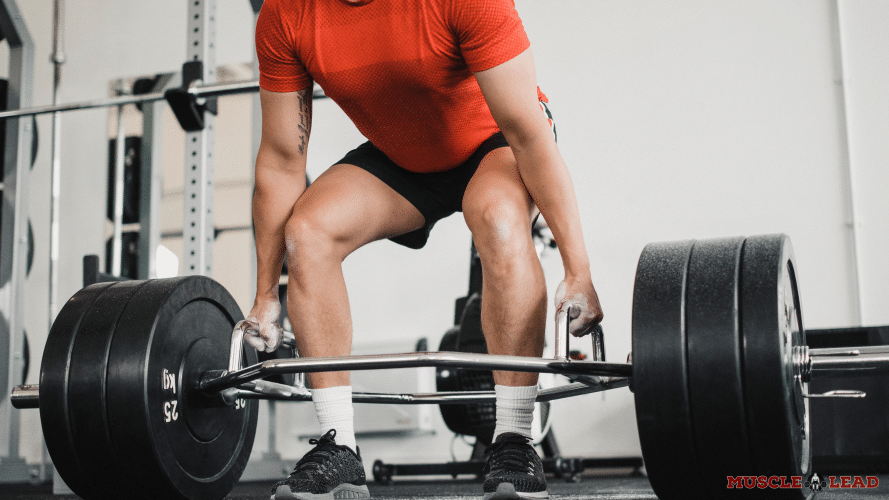I have a confession to make about the hex bar deadlift.
When I started lifting, I could just about deadlift the 45-pound bar, and even that was done incorrectly.
Then, one of the gym trainers recommended the hex bar variation as the ‘beginner-friendly alternative’.
It felt safe, effective, and flowed so much better than the straight bar.
Over the next 12 months, regular hex bar deadlifting built me up so well. In fact, it put enough lean mass on my frame that I looked well muscle-bound.
Starting from a measly 45-pound bar in 2009 to a fully blown 396-pound stack of 4 solid iron plates in 2010.
IT WAS AWESOME!
If you are interested in learning about the hex bar deadlift benefits, we have explored 9 of them, so stay tuned.
9 Hex Bar Deadlift Benefits
As a matter of fact, we know there are many benefits of the hex bar deadlift. However, we only included 9 that we believe to be most relevant for you guys (and gals).
1. Element of Sport Transferability
The kinetic chain of movements (ankle, knee, hip extension) during the hex bar deadlift is similar to many sporting movements like jumping and sprinting. This is because the mechanics are similar to the muscles being used (1).
So, by using the hex bar deadlift, essentially you are strengthening the motor patterning of sports (1).

Not to mention, weights on the hex bar are lifted from the side of the body. This shifts the center of gravity to a more natural position, similar to sports (1). In fact, the hex bar deadlift is a coach’s choice for a strength or strength-speed phase of an athlete’s S&C program.
2. Muscular Strength & Hypertrophy
In fact, to perform the hex bar deadlift an impressive amount of muscle tissue is brought into action. So, done properly, it can activate many muscles of the legs, arms, and back (2).
To be specific, these muscles include:
- Core stability (midsection)
- Calf (lower leg)
- Quadriceps (thighs)
- Glutes (butt)
- Brachioradialis (forearm)
- Trapezius (upper back)
- Latissimus dorsi (outer back)
- Rear deltoids (back of shoulders)
Over the long halt of hex bar deadlifting, these muscles could become bigger and stronger.
Learn about Should Lower The Weight When Deadlifting?
3. Emphasizes the Bracioradialis
There are a couple of grips that are commonly used during the barbell variations of the deadlift (2).
So, these include the double overhand or mixed grip. From the nature of these grips, we would expect the brachialis and biceps to be targeted (3). The lack of safety from the mixed grip is another rant altogether.
On the other hand, the Hex bar deadlift has a unique semi-pronated grip position (hammer grip) (2). For this reason, the Hex bar is one of the only deadlift variations that hits the Bracioradialis.
Learn about Deadlifting Barefoot vs in Lifting Shoes
As a matter of fact, the brachioradialis is the muscle that runs down the outer forearm.
4. Emphasizes the Glutes & Upper Back
When we think about muscle activation in the glutes and traps, the movement actions start at the hip hinge and shoulder blades (3).
The Hex bar handles are higher off the ground compared to a straight bar. This cuts some of the range of motion that would normally be seen in other barbell variations (3).
Additionally, this allows us to apply our efforts in the hip extension (straightening hips) and scapular retraction parts of the lift (pin shoulder blades) (3).
In turn, emphasizing the glutes and traps. With long-term use of the hex bar, we may see more gains in these muscle groups.
Read more about the 10 Best Barbell Hip Thurst Alternatives for a Strong Butt
5. Lift Heavier Loads During Hex Bar Deadlift
As we know, the hex bar handles are higher than a straight bar.
This does two things. Demands less range of motion and puts the body into a stronger position.
By stronger position, I mean the body may be flexed just enough to get an optimal muscle fiber cross-bridging. So you may be able to load up more weights and show off a more impressive lift.
Personally, I can load up two extra 44-pound plates. Lifting an additional 88 pounds.
6. No Shin Damage
One of the great hex bar deadlift benefits is it keeps you isolated. You are basically lifting from the caged bar.

Unlike the barbell variations of the deadlift, the hex bar does not scrape against the shins. So you do not need to worry about bloody or bruised shins.
How to Avoid Scraping Your Shins When Deadlifting
Moreover, with the barbell variations, there is a small chance of catching a contagious disease.
Say if someone else’s blood was already on the bar.
7. Hex Bar Deadlift Can Be Safer
There are 3 reasons I can give you why the hex bar may be safer than the barbell variations.
- Less chance of bicep rupture – the semi-pronated is a stronger and much safer listing than say the mixed grip.
- No shin damage or chance of catching blood-borne diseases – No bar sliding up the shin so you should not get a Shin injury or catch a blood-borne disease
- Less spinal loading risk – From the center of gravity there is less risk of the spine curving forwards. Barbell variations pose more risk as the weight is in front of the body
10 Common Deadlift Injuries and How to Prevent Them
8. Adds Variation to a Lower Body Workout
Just going for the same type of deadlift week in and week out can get boring.
In fact, boredom can reduce the amount of exertion that you apply to the deadlift. This can result in a decline in fitness levels.
By simply including and periodizing the hex bar deadlift, you may be able to bring some excitement back into your workout.
Thus keeping the fitness gains moving forwards and upwards.
9. Beginner-Friendly Variations
In fact, the proper deadlifting form takes a considerable amount of motor learning.
Essentially, the lower and upper body have to work together to lift a bar off the ground. For a beginner, this may be difficult at first.
In my opinion, the hex bar is a more beginner-friendly variant as the center of gravity, back, and arm positions are more natural.
Furthermore, the hex bar handles are higher than a barbell. This means that the lift is much easier on the range of motion. So, it’s somewhat similar to an elevated deadlift or block pull.
So YES! I would certainly recommend the hex bar deadlift to anyone who is learning the deadlift mechanics.
How to Perform the Hex Bar Deadlift?
So, if you are interested in trying out the hex bar deadlift variant, I have highlighted the key steps below to perform it safely and effectively.
STEP 1: Find a clear space in the gym suitable for deadlifting with the hex bar. Place a Hex bar on the floor
STEP 2: Load the hex bar depending on your training phase. Ensure you start off lower than normal.
STEP 3: Stand in the center of the hex bar. Place the feet in your natural jumping position.
STEP 4: Grasp the vertical handles in a position where it feels most comfortable Drop the hips, bend at the knees, and shift your weight to your heels.
STEP 5: Change the position of your feet, if needed. Better to be comfortable in the position.
STEP 6: Take a deep breath and brace the muscles on the trunk. Brace the core.
STEP 7: Press from the ball of the foot while straightening the knee/hips.
STEP 8: Finish by bringing the weight up. Pin the shoulder blades backward.
STEP 9: Breathe out and place the bar back at the starting point.
STEP 10: Repeat the movement for desired sets and reps.
Final Thoughts
All in all, the hex bar deadlift is a great variation of the conventional deadlift. It has 9 incredible benefits which include:
- Sports Transferability
- Muscular Strength & Hypertrophie
- Emphasizes The Brachioradialis muscle
- Emphasizes The Glutes & Traps
- No Shin Damage
- Safer Variation
- Lift Heavier Loads
- Adds Variation To A Workout Program
Now the question is, are you going to give it a go? Happy lifting.
Frequently Asked Questions
In some ways YES! It is safer, works certain muscles better, and is more beginner-friendly.
They’re good for a lot of things like; gym gains, sports, safety, variation.
As we know, there are 9 fantastic pros of the hex bar deadlift to help you towards your fitness goals. To be honest, there are no major cons.
References
- Munger, C.N., Leyva, W.D., Archer, D.C., et al. ‘Comparison of Hex Bar Deadlift vs. Back Squat Postactivation Potentiation on Vertical Jump Takeoff Velocity’ Medicine And Science In Sport And Exercise. 2016; 48(5): 935–935
- Camara, K. ‘An examination of muscle activation and power characteristics while performing the deadlift exercise with straight and hexagonal barbells’ California State University, Fullerton. 2015 (Dissertation thesis)
- Anderson, V., Filmland, M.S., MO, D.A., et al. ‘Electromyographic comparison of barbell deadlift, hex bar deadlift, and hip thrust exercises: a cross-over study’ The Journal of Strength & Conditioning Research. 2018; 32 (3): 587–593





